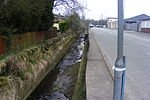Shaw and Crompton tram stop

Shaw and Crompton is a tram stop on the Oldham and Rochdale Line (ORL) of Greater Manchester's light-rail Metrolink system. It opened to passengers on 16 December 2012 and is located in Shaw and Crompton, a part of the Metropolitan Borough of Oldham, England. The station sits adjacent to the site of the original Shaw and Crompton railway station, a regional rail station which opened (initially for haulage) on 2 November 1863 and closed on 3 October 2009 for conversion to Metrolink. Known as Shaw railway station between 1974 and 1989, it was along the Oldham Loop Line, which operated from Manchester to Rochdale via Oldham and thus was almost identical to the current Metrolink route.
Excerpt from the Wikipedia article Shaw and Crompton tram stop (License: CC BY-SA 3.0, Authors, Images).Shaw and Crompton tram stop
Beal Lane,
Geographical coordinates (GPS) Address Nearby Places Show on map
Geographical coordinates (GPS)
| Latitude | Longitude |
|---|---|
| N 53.57618 ° | E -2.08953 ° |
Address
Shaw and Crompton
Beal Lane
OL2 8UY , Clough
England, United Kingdom
Open on Google Maps






